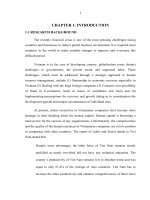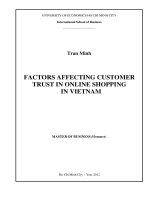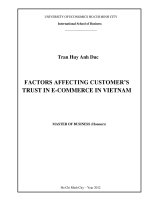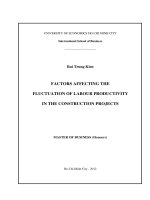FACTORS AFFECTING CUSTOMER LOYALTYIN THE VIETNAMESE TELECOMMUNICATION MARKET
Bạn đang xem bản rút gọn của tài liệu. Xem và tải ngay bản đầy đủ của tài liệu tại đây (313.64 KB, 56 trang )
ACKNOWLEDGEMENT
I would like to show my great gratitude to following people who made this thesis
possible.
I consider it an honor to work with Dr Nguyen Thi Nguyet Que whose
encouragement, guidance and support from the initial to the final level enabled me
to develop an understanding of the subject.
It is a pleasure to thank my colleagues who brought sincere help during the
completion of the study.
I owe my deepest gratitude to my family and friends who inspired me my final
effort to accomplish this dissertation.
PLAGIARISM STATEMENTS
I would like to declare that, apart from the acknowledged references, this thesis
either does not use language, ideas, or other original material from anyone; or has
not been previously submitted to any other educational and research programs or
institutions. I fully understand that any writings in this thesis contradicted to the
above statement will automatically lead to the rejection from the MBA program at
International School of Business University of Economics, HCMC
COPYRIGHT STATEMENT
This copy of the thesis has been supplied on condition that anyone who consults it
is understood to recognize that its copyright rests with its author and that no
quotation from the thesis and no information derived from it may be published
without the author’s prior consent.
© Luong Dang Khoa / ISB-MBUS/2010-2012
ABSTRACT
Purpose: This study shows us factors that contribute to customer loyalty from
customers of Telecommunication service organizations in Viet Nam beside factors
in original ACSI/ECSI model as: image, expectation, perceived value, satisfaction,
complaint….Moreover author also considers the direct relationship between
perceived service quality and customer loyalty instead of through customer
satisfaction as the original ACSI and ECSI
Finding: This study finds out that beside factors in original ACSI-ECSI models,
service customization and communication also have positive affection to customer
loyalty. Beside that a direct and significant relationship between Perceived Service
Quality and Customer loyalty is also recognized.
Design: This research has based on ACSI/ECSI model and ECSI extended models
to measure Perceived Service Quality, Customization, Communication and
Customer loyalty. 200 questionnaires will be issued to collect data.
Limitations and implication: this study has its limitations in terms its scope
which focused only Telecommunication organizations in Viet Nam. Beside that
many factors that can affect customer loyalty such as: switching cost, economic
cost, transaction cost, call center, in-different services, price perception and
inertia…. are not mentioned in this study. For business owner or directors of
organizations, this study can help how to create Customer loyalty in their
organizations. This study is also helpful for researchers to extend its scope to other
business field and other geographic areas outside VietNam.
Keywords: Customer loyalty, Perceived Service Quality, Service Customization,
Communication
Table of Contents
ABSTRACT 4
Table of Contents 5
Chapter 1: INRODUCTION 1
1.1Research background 1
1.2Research objectives 3
1.3Scope of this research 3
1.4Research method 4
1.5Research structure 4
Chapter 2: LITERATURE REVIEW 6
2.1Introduction 6
2.2Literature review 6
2.2.1Customer loyalty 6
2.2.2Perceived service quality 7
2.2.3Service customization 9
2.2.4Communication 11
2.3Model and Hypotheses 12
2.4 Summary 12
Chapter 3: RESEARCH METHODOLOGY 13
3.1Introduction: 13
3.2Research process 13
3.3Operationalization of measurement scales 14
3.4Questionnaire Design 16
3.5Pilot study 17
3.6Main survey 22
3.6.1Target population 22
3.6.2Sample size 22
3.6.3Sampling method 23
3.6.4Questionnaire administration 23
3.7Methodology of data analysis 24
3.8Summary 24
Chapter 4: DATA ANALYSIS 25
4.1Introduction 25
4.2Data cleaning 25
4.3Sample description 26
4.4Reliability test 27
4.4.1Customization 27
4.4.2Perceived Service quality: 28
4.4.3Communication 29
4.4.4Customer loyalty 31
4.5Factor analysis 32
4.6Correlation and Regression 38
4.6.1Correlation 38
4.6.2Regression assumption testing 39
4.6.3Regression analysis 39
4.7Summary 43
Chapter 5: CONCLUSIONS AND IMPLICATIONS 45
5.1Introduction 45
5.2Findings and contributions 45
5.3Limitations and recommendations for future research 47
LIST OF TABLES
Table 1: List of indicators
Table 2: Results of Cronbach’s alpha for dimension Customization (pilot test):
Table 3: Results of Cronbach’s alpha for dimension Perceived Service Quality
(pilot test):
Table 4: Results of Cronbach’s alpha for dimension Communication (pilot test):
Table 5: Results of Cronbach’s alpha for dimension Loyalty (pilot test):
Table 6: Characteristics Of Respondents
Table 7: Results of Cronbach’s alpha for dimension Customization (main survey):
Table 8: Results of Cronbach’s alpha for dimension Perceived Service Quality
(main survey): :
Table 9: Results of Cronbach’s alpha for dimension Communication (main
survey):
Table 10: Results of Cronbach’s alpha for dimension Customer loyalty (main
survey):
Table 11: Results of EFA testing (1
st
)
Table 12: Results of EFA testing (2
nd
)
Table 13: New Factors
Table 14: Results of Cronbach’s alpha for new dimension Communication:
Table 15: Results of Cronbach’s alpha for new dimension LOYALTY:
Table 16: Model summary (MLR)
Table 17: Coefficients (MLR)
Table 18: Model Summary (SLR)
Table 19: Coefficient (SLR)
Table 20: The confirmation of hypothesis
1
Chapter 1: INRODUCTION
1.1 Research background
As many researchers have conducted, customer loyalty is one of the most
important thing in business nowadays, and that it is more profitable to retain
customers than to acquire new ones (John, Katherine & Libai, 2003; Liz Lee-
Kelley, Gilbert & Mannicom, 2003), so how to retain customers is one of the key
of success of organizations, and especially in telecommunication business in Viet
Nam where the market almost nearly saturated (P.V, 2012) so customer loyalty is
becoming competitive advantages for organizations to compete, develop and
survive on this market. On over the world many models are used to measure
customer loyalty such as: Servqual, Servperf, ACSI, ECSI…
Telecommunication market in VietNam is now ready for matured with 3 biggest
suppliers: Viettel, MobilePhone, Vinaphone that got more than 95% market share
(P.V., 2012) and other smaller suppliers: S-Phone, VietNam Mobile, Beeline
(now is called G-mobile). Telecommunication market is now becoming the game
play of big 3 Viettel, Mobifone and Vinaphone. There are few differences in
Vietnamese telecommunication market between now and 3-5 years ago. In the past
how to attract new customers is the most important thing to service providers,
service providers are always try to attract new customers as much as possible, but
at this time this strategy is not the most important one, and in long-term how to
retain customers is much more important than attracting new customers. So beside
of attracting new customers, how to make customers retain to service providers are
considered carefully and become the critical factors for service providers to
survive and develop in this market, so research on customer loyalty and its
antecedents such as perceived service quality and other factors can be a very
importance for service providers (Santouridis & Trivellas, 2010, p.332). Few
researchers have also researched for customer satisfaction and perceived service
quality in VietNamese Telecommunication market and most of them based on
2
original models such as: Servqual (Parasuraman, Zeithaml & Berry, 1988),
Servperf (Cronin & Taylor, 1992&1994), and non of them explain directly
customer loyalty. On the world there are many models can explain directly
customer loyalty such as ACSI (American Customer Satisfaction Index)/ ECSI
(European Customer Satisfaction Index) and they are adapted by
telecommunication industry in many countries.
The ACSI/ECSI model is considered well-established tool (Gronholdt, Kristensen,
& Martensen, 2000; Cassel & Jan, 2001; Vilares &Pedro, 2003), many researchers
on the world are based on ACSI/ECSI to measure customer satisfaction and
customer loyalty, and ACSI/ECSI is really an effective instrument to measure
them. This tool is adapted by American and almost European countries and in
many industries (insurance, telecommunication phones, fixed phones, carbonated
soft drinks, public transportation, retail banking, cable TV, supermarkets, postal
services, food products, and public service) Pedro, Jörg Henseler (2012).
Moreover it is also adapted by many countries and many industries in Asia such as
Iran (Kaveh, Seyed & Ghaedi,2012), Singapore (Yew-Wing & Bellman,2008),
Korea –KCSI (Chun-Seon, Soung-Hie, & Joon-Young,2006).
ACSI/ECSI indeed is an effective tool but nowadays there are much more factors
than the original model can affect customer loyalty. These factors exist in many
researches such as service customization (Pedro, Jörg Henseler,2012) and
communication (Ball, Pedro & Machas,2003). These factors have a significant
affect to customer loyalty in many industries on over the world. This research
focuses on customer loyalty of telecommunication service business in Viet Nam,
and is also based on ACSI (American Customer Satisfaction Index)/ ECSI
(European Customer Satisfaction Index) model and partly from modified or
extension ECSI model from Pedro & Jörg Henseler (2012) and Ball, Pedro &
Machas (2012). In Viet Nam where businesses are still affected by relationship
and empathy, these new factors (service customization and communication) can
3
have a significant impact on customer loyalty so they should be checked
empirically in Vietnamese telecommunication market and managers of these
telecommunication organizations can use this result as a reference for strategies to
increase customer loyalty.
More than that in Viet Nam where perceived service quality from
telecommunication organizations is still a problem and perceived service quality is
one of the most important antecedents and predictors of customer loyalty
(Santouridis & Trivellas,2010; Hyung, 2010) but in ACSI/ECSI models, customer
loyalty is measured mainly by customer satisfaction and corporation image (Ball,
Pedro & Machas,2003, p. 1273), it does not exist in the relationship between
perceived service quality and customer loyalty. This relationship also should be
checked empirically in Vietnamese telecommunication industry.
1.2 Research objectives
Based on background and problems above, objectives of this research are:
- Identify the impact of newly developed factors that did not exist in original
ACSI/ECSI model such as : service customization and communication on
customer loyalty
- Identify the directly impact of perceived service quality on customer loyalty
based on ACSI/ECSI model.
- To recommend strategies for VietNamese telecommunication organizations
in increasing their customer loyalty.
1.3 Scope of this research
This research focuses on customers that are using telecommunication services in
Viet Nam, respondents are customers who are using telecommunication service
providers from operators such as: Mobifone, Vinaphone, Viettel.
4
1.4 Research method
The sampling procedure used by the author was convenience sampling through
survey, the participants restrict to those who used the telecommunication services
in Viet Nam. To approach target sample, author uses his own relationship to
contact participants
Author uses software SPSS 17.0 to analyze and test reliability, validity, data
reduction, the significance of this research. Cronbach’s alpha method will be used
to test reliability of the measurement scale. EFA (Explore factor analysis) will be
used to test validity of the measurement scale and for data reduction purpose. SLR
(simple linear regression) and MLR (Multiple linear regression) will be used to
test the relationship between variables in this research.
1.5 Research structure
Chapter 1: Introduction. Research introducing will give the overview information
of the research
Chapter 2: Literature review and hypotheses: Literature review will review the
theoretical of customer loyalty, service customization, communication and
perceived service quality and review the theoretical relationship between them.
Moreover this chapter will show information about the model and hypothesis will
be tested in this research
Chapter 3: Research method: This chapter present research conceptual
framework, measurement instrument, method of data collection and method of
data analysis.
Chapter 4: Data analysis and results: This chapter will show the results of
questionnaire survey .
5
Chapter 5: Conclusion and implications. Based on results of research, this chapter
will explain how marketers and managers in telecommunication market can apply
to increase customer loyalty moreover this chapter will present scopes and also
limitations of this research and imply how to apply this research correctly also
how to develop this research further.
6
Chapter 2: LITERATURE REVIEW
2.1 Introduction
This chapter reviews theories and provide some studies about variables used in
this research such as: customer loyalty, perceived service quality, service
customization and communication. This chapter also proposes hypotheses and
model that will be tested in this study.
2.2 Literature review
2.2.1 Customer loyalty
Customer loyalty topic has been measured by practitioners many years ago and
concept of loyalty construct has evolved and developed over years Caruana
(2002). Customer loyalty can be described as repurchasing service, cognition
about service and attitude about service, that mean customers will repurchase
services from providers if they need their services, moreover with attitude about
services, they will use “word of mouth” to recommend these services to other
customers, and with cognition about these services, customers will have a affective
loyalty about services, some bias will exist. As stated by Gremler & Stephen.
(1996, p.173) “The degree to which a customer exhibits repeats purchasing
behaviors from service provider, possesses a positive attitudinal disposition toward
the provider, and consider using only this provider when needs for this service
exist”.
Czepiel & Gilmore (1987, as cited in Lee & Cunningham, 2001, p.116) defines
customer loyalty is an attitude of customers in continuing exchange relationship
with service provider based on experience of these customers. One another
definition about customer loyalty is the intentions of customers re-use services
from their current service provider based on past experiences in using services and
their expectations about future services Lee & Cunningham (2001, p.116).
7
2.2.2 Perceived service quality
According to ACSI, ECSI model, perceived service quality is the evaluation
between served market and recent consumption experience (Fornell, Johnson,
Anderson, Cha & Bryant, 1996, p.9) and model of perceived service quality
include two parts, one is quality of services or products offered according to
customers perception and one is belong to service featured like: after sale services,
guarantees, documentation, …. sometimes these 2 parts are called “hardware
quality” and “software” quality (Marie-Paule, Anne de la Foye, Carole &
Michel,2000, p.362)
Another definition , perceived service quality is the result from the comparison of
customers between perception about the services they have used and their
expectations of customer about these service Caruana (2002, p.813), or stated by
Parasuraman,Zeithaml & Berry (1988, as cited in Saif, 2012, p.69) “perceived
service quality is defined as consumers’ judgment about a business’s overall
distinction or dominance”, and perceived service quality is used to measure the
extent of services provided in comparison with customers expectations (Angelova
& Zekiri, 2011, p.245)
The same definition is defined by Jiang & Wang’s study (2006, as cited in Saif,
2012, p.69) “perceived service quality is the consumer’s evaluation of the service
performance received and how it compared with their expectation” and
“evaluations are not based on service attributes; rather these depend on a
customer’s feelings or memory” Saif (2012, p.69) stated. So perceived service
quality can be define as how customers evaluate and experience firm’s service,
and perceived service quality is therefore viewed as “the degree and direction of
discrepancy between consumers’ perceptions and expectations” Parasuraman,
Zeithaml & Berry(1988, p.1) stated. Perceived service quality is also formulated
by Saif (2012, p.70): “Perceived Service Quality = Service Perception – Service
Expectation”.
8
In original ACSI and ECSI model, there is no relationship between perceived
service quality and customer loyalty, this exists a mediator role of customer
satisfaction. But In this study, after checking with many customers about
perceived service quality and customer satisfaction in VietNamese
Telecommunication context, author realized that there are some confuses in
meaning between perceived service quality and customer satisfaction. Customers
always confuse about these two factors in interviewing.
Many empirical researches show that perceived service quality is one of the key of
profitability of company and is one dimension for customers to have repurchase
intentions (Hyung, 2010, p.4). Simon, Auh,& Smalley (2005, p.178) in their
researches also confirm that perceived service quality ( both technical service
quality and functional service quality) has a positive relationship with customer
loyalty. Many other researches also confirm this hypothesis as Bloemer, Ruyter &
Wetzels (1998) and Aydin & Özer (2005), Cronin, Brady, Brand, Hightower&
Shemwell (1997) , Cronin, Brandy,& Hult (2000) , Levesque & McDougall(1996)
and Zeithaml, Berry &Parasuraman (1996). Especially in Telecommunication
Market many empirical researches show that perceived service quality have a
direct impact on customer loyalty and is major predictor of customer loyalty
(Santouridis & Trivellas, 2010, p.339; Hyung, 2010, p.4).
Based on theories and empirical researches and results from interviewing with
customers author decides to remove satisfaction factor in original model and
consider the direct relationship between perceived service quality and customer
loyalty.
So author hypothesizes:
Hypothesis H1: “Perceived service quality has a positive impact on customer
loyalty”
9
2.2.3 Service customization
There is some confusion about service customization and service personalization,
but in this research, the literature of customization and personalization can be used
as the same meaning.
Nowadays with development of computing and Internet, customers now become
more demanding. So many service corporations chose service customization is one
approach for their competitive advantages; Customization has always been a
feature of products and services when marketers have had the resources to use
personalization for competitive advantage (Ball, Pedro, & Vilares, 2006, p.393).
Moreover Pedro & Jörg Henseler (2012) points out that “over the past decades,
there has been a growing recognition among scholars and practitioners that
product and service differentiation represents a source of competitive advantage”.
The core idea of differentiation is to identify profitable market segments and to
design products and services to optimally satisfy the needs of the target segments
and as a more extreme form of differentiation, the concept of customization –that
means the degree to which the firm’s offering is tailored to meet heterogeneous
customers’ needs (Eugene, Fornell & Roland, 1997). The goals of customization
services from organizations are to serve their customer needs in which resources
they have, as Tapscott (1997, as cited in George & David, 1999, p.19) argued and
customization service is “ability to target individual, engages in dialogue with
them, and personalize an offering that meet their requirements”.
According to statements from Peppers & Rogers(1993, as cited in Ball,Pedro &
Vilares, 2006, p.393) “personalization has largely been assumed to affect
satisfaction and loyalty”, and because of the nature of personalized service, it is
always better service when organizations have focus on specific customer needs.
Ball,Pedro & Vilares (2006, p.393) points out that “personalized service should
simply be better service than routine service that does not take the individual’s
needs into account” and “the rationale makes common sense: personalization
10
should produce a more satisfactory transaction, and over time, a more satisfactory
relationship”. With delighting customers through customized service, service
providers can make their customer satisfied because service performance is higher
than customer’s expectations so “high customization through discovery of latent
needs and provision of tailored solutions can heighten customer loyalty” as
Wang,Wang,Ma, & Robin (2010, p.6) argued.
Moreover Ostrom & Iacobucci (1995) shows that customization is a signal of high
service quality and Ennew & Binks ‘s study (1996, as cited in Pedro & Jörg
Henseler 2012, p.334) also states “there is also empirical support for the notion
that customization in the service delivery process is a dimension of service
quality”.
In another argument, customers tend to stay with current service supplier when
switching cost is high or attractiveness of alternatives cannot overcome
attractiveness of offers from current supplier (Pedro & Jörg Henseler 2012). One
of reason why customization create switching cost and increase attractiveness of
current offer is because customization require mutual investment in to relationship
(Pedro & Jörg Henseler 2012, p.335). Customers have to invest their effort to
explain what their needs and requirements, suppliers will put their effort to
examine these needs and requirements to satisfy their customers. There is
existence a renunciation of economic scale in customization (Pedro & Jörg
Henseler 2012, p.335). Moreover in the essence, when an attractiveness of current
offers is increasing that mean decreasing in attractiveness of alternatives. So they
will create switching cost or setup-cost (Thomas,Judy & Mahajan, 2003) because
when customers want to switch to other suppliers, they need to put their effort to
train new suppliers. All these things will create an equity called “retention equity”
(Rust, Zeithaml & Lemon, 2000) and lead to customer loyalty (Ball,Pedro &
Vilares, 2006).
So with all information from these literatures, author can hypothesize:
11
Hypothesis H2: “Service customization has a positive impact on perceived
service quality”
Hypothesis H3: “Service customization has a positive impact on customer
loyalty”
2.2.4 Communication
As defined by Ball, Pedro & Machas (2004) communication is how we interact
with customers in positive way and give helpfulness to customers, “by
communication, we refer to written communications such as personalized letters,
direct mail, Web site interactions, other machine-mediated interactions, and e-
mail, as well as in-person communication with service personnel before, during,
and after service transactions” Ball, Pedro & Machas (2004, p.1277) , and
communication is the key of customer satisfaction and loyalty (Nolan,1999,p.107)
According to MacStravic (1987, as cited in Dawn Bendall-Lyon & Thomas, 2003,
p.591) communication is important in customer’s belief and attitude and is
important in increasing satisfaction and loyalty. This communication will be
considered in one way method, that mean this is not dialogue with customers as
definition of Bruhn & Michael (2000, p.1024) about “customer dialogue”, this is
just one way from service organizations and not vice versa (Ball, Pedro & Machas,
2004, p.1277). There are many evidences that show communication has a highly
impact to customer loyalty and satisfaction (Ball, Pedro & Machas, 2004), and
“helpful, clear, and personalized information and advice not only enhance
satisfaction and trust, but also loyalty, to a significant extent” (Ball, Pedro &
Machas ,2004, p.1284). With the same findings from Katherine, Roland& Valarie
(2001), Michael, David & Sharon (2000), Parasuraman, Leonard & Valarie (1991)
proves that positive communication will lead to obtain customer loyalty.
So based on literature, author hypothesizes:
Hypothesis H4: “Communication has a positive impact on customer loyalty“
12
2.3 Model and Hypotheses
Proposed model
Based on the literature review, author develops hypotheses and theoretical
framework of the model:
H1: Perceived service quality has a positive impact on customer loyalty
H2: Service customization has a positive impact on perceived service quality
H3: Service customization has a positive impact on customer loyalty
H4: Communication has a positive impact on customer loyalty
2.4 Summary
This chapter reviews some results of related topics which have relationship
between service customization and perceived service quality, and relationship
between service customization, communication and customer loyalty. These topics
are almost based on ACSI/ECSI model and called ACSI/ECSI extended model
however in original ACSI/ECSI model, there is not a direct relationship between
13
perceive service quality and customer loyalty, but in this research author considers
this direct relationship.
Chapter 3: RESEARCH METHODOLOGY
3.1 Introduction:
This chapter showed more detail about the research process, operationalization of
measurement scales of this research, in additional this chapter also provided
information of sample such as: sample size, sample approach method in main
survey, method of data cleaning after survey. Beside that this chapter provided
information about questionnaires design, results of pilot process. In the end, this
chapter also provided methodology for data analysis for this research.
3.2 Research process
This part showed a flowchart of methods used in this research, this chart will also
outline steps in this chapter.
14
3.3 Operationalization of measurement scales
Constructs in this proposal were almost based on American Customer Satisfaction
Index (ACSI model) and European Customer Satisfaction Index (ECSI model) and
some from ECSI extended model. Indicators that used to measure perceived
service quality have been used by Pedro, Jörg Henseler (2012), Turel & Serenko
(2006) and Tung (2010). Customer loyalty factor was measured by indicators that
Objectives
Objectives
Literature Review
Literature Review
Draft questionnaire
Draft questionnaire
Proposed research model and
hypotheses
Proposed research model and
hypotheses
Pilot study
Pilot study
Final questionnaire
Final questionnaire
Main survey
Main survey
Data analysis
Data analysis
Writing report
Writing report
15
have been used in Pedro, Jörg Henseler (2012), Fornell, Johnson, Anderson, Cha
& Bryant (1996), Marie-Paule, Anne de la Foye, Carole & Michel (2000), Makam
(2009) and Tung (2010). All these 2 factors are main factors of ACSI and ECSI
model, these factors have measured in the context of many countries (include
Asia) and industries (include telecommunication industry) on over the world.
Service customization was measured based on Pedro & Jörg Henseler (2012) and
Ball, Pedro, & Vilares (2006). Indicators that used to measure communication was
based on Ball, Pedro & Machas (2004). Five point rating scale was used to
measure these indicators in this model (1 for lowest and 5 for highest). Table
below presented a detailed list of indicators used in the measurement model.
Table 1: List of indicators
Variable Coding Indicators
Service
Customization
CUS01 My service provider offers me products and
services that satisfy my specific needs (totally
disagree to totally agree)
CUS02 My service provider offers products and services
that I couldn’t find in another company (totally
disagree to totally agree)
CUS03 If I changed between service provider I wouldn’t
obtain products and services as customized as I
have now (totally disagree to totally agree)
Quality QUA04 Quality of products and services (very low to
very high)
QUA05 Reliability of products and services (very low to
very high)
QUA06 Diversity of products and services (very low to
very high)
QUA07 Global quality of the company (very low to very
high)
QUA08 Meet personal requirements (very low to very
high)
16
Communication COM09 I have an easy and satisfactory relationship with
my service provider (totally disagree to totally
agree)
COM10 The service provider keeps me constantly
informed of new products and services that could
be in my interest (totally disagree to totally
agree)
COM11 Personal service and advice of my service
provider (very low to very high)
COM12 Clearness and transparency of information
provided by service provider (very low to very
high)
Loyalty LOY13 Probability to choose “my service provider”
again when buying new product or service (very
unlikely to very likely)
LOY14 Probability to recommend “my service provider”
if a friend or a colleague asked for your advice
(very unlikely to very likely)
LOY15 If a competitive provider offers you the same
range and quality of services as you currently
receive, by how much should their prices be
lower than those you are currently paying for you
to change your current provider? (very low to
very high)
LOY16 Intentions to stay loyal to “my service provider”
3.4 Questionnaire Design
Questionnaires for this survey were based on ACSI and ECSI models from Pedro
& Jörg Henseler (2012), Turel & Serenko (2006) and ECSI extened model from
Ball, Pedro & Machas (2004); Ball, Pedro, & Vilares (2006) and then modified
and adjusted according to results by wording through interview from customers.
Wording process was conducted by interviewing 10 respondents (3 from
Mobifone, 3 from Viettel, 3 from Vinaphone and 1 from Sfone) to know how
17
much they understand about these questionnaires (after translated in to
Vietnamese), and let them show their recommendations and suggestions so that
they and everybody can easily understand the main meaning of each questionnaire,
after that through recommendations and suggestions from these customers, author
collected and finalized this questionnaires table.
Structure of questionnaires was divided in three parts:
o Part 1 was general information of the customers including main Operator
using and Usage Period of this operator.
o Part 2 included 16 statements based on ECSI and Extended ECSI instrument.
Each statement is measured on a 5-point Likert scale ranging from strongly agree
(5) to strongly disagree (1) to measure customer perceptions.
o Part 3 was general demographic of the participants including Age, Sex,
Martial status, Occupation.
3.5 Pilot study
A convenience sample size with 80 questionnaires were issued to respondents and
collected (author used Google Doc to create a questionnaires table with content is
the same as content of softcopy and hardcopy version. Google Doc will create a
link, customers after accessing this link and complete questionnaires, results were
recorded automatically in Google Docs) to test reliability of this instrument, after
that author rejected items that were not related in this instrument, discovered
issues and problems in structure and content of questionnaires. Cronbach’s alpha
coefficient was computed to test reliability of this instrument. The next, EFA
method was used to preliminarily estimate scale to test uni-dimension, convergent,
and discrimination attributes of measurement scale. After Pilot study,
questionnaires were used for survey in large numbers.









